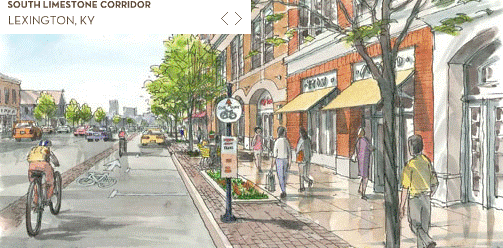(Part of the To-Do List for Lexington series. Click here for an overview and links to the rest of the series.)
Last week, Lexington’s Urban County Council deliberated on the projects the city would issue bonds for. When we issue bonds, we are borrowing money from bond investors – Bonds are new debt that we will pay off at some point in the future to fund today’s projects.
In that bond deliberation process, one word kept coming up: Streetscapes.
The council has earmarked some $30 million in new bonds for four streetscape projects. In addition to funding the ongoing project on South Limestone (whose ever-escalating price tag now stands at $17 million), the council will fund new streetscape projects on Cheapside, West Main, and West Vine for $12.7 million.
All four projects are slated for completion by July 1st, 2010 – less than 7 months from now.
Barely two weeks earlier, the Mayor announced a $12 to $13 million shortfall in the current year’s budget, noting that – after several previous rounds of cuts – the city would likely have to cut services to balance its budget this time.
Yet, in this economically-strapped environment, the Mayor pushed for (and council approved) a disruptive $30 million spending spree to make streets look pretty.
Why the rush? The World Equestrian Games are coming to Lexington in September 2010, and we must look our best for “the world”.
This is boosterism run amok: In the mad scramble to make Lexington ‘pretty’ for out-of-town visitors next fall, the city is simultaneously 1) spending $30 million to make streets look better, 2) incurring $30 million in new bond debt, and 3) destroying $90 million of economic value by disrupting local business operations.
And the next 6 months promise to be even more disruptive, as the four separate street projects further entangle downtown Lexington.
In the face of financial crisis, massive spending on discretionary aesthetic projects – especially ones which disrupt commerce – seems wildly irresponsible. It is the urban equivalent of not being able to make the mortgage payment, yet getting a new loan to redesign the landscaping.
::
Last January, at the request of Lexington’s Mayor, a group of citizens delivered a long-term vision for our city to the Mayor and to the Urban County Council. Dubbed Destination 2040, the document outlined strategies and initiatives for maintaining “great city life in a productive rural paradise” for the next 30 years in Lexington.
I have previously written that I believe that Destination 2040 is destined to fail. I make that assessment not because there is anything fundamentally wrong with the Destination 2040 vision, but because Lexington lacks the mechanisms and processes to realize such a vision.
::
Together, streetscapes and Destination 2040 provide a snapshot of Lexington’s inability to implement strategic economic and urban development plans.
At the scale of decades, Destination 2040‘s objectives are too distant to grapple with in a systematic fashion. It is too difficult to tangibly connect today’s initiatives to the distant future.
At the scale of months, the scramble for streetscapes is ripped from a broader strategic context: Are these really the wisest investments for our city to make while facing a very distressed economic environment? What emerges from such short-term focus is a series of disconnected, momentarily-important initiatives with spotty results.
Lexington needs t0 better connect its near-term projects to its long-term vision. We need to invest in projects which fit within well-defined urban development goals. We need to clearly articulate a coherent strategy for sustainable growth.
Lexington needs to learn to plan well.
Planning isn’t very exciting to talk about, but it is critical that we do it well – especially when we are incurring public debt that we’ll be paying back over several years. So here are some thoughts on how Lexington can better plan its future.
Choose big, specific, near-term goals.
Lexington needs to choose audacious goals, and then work diligently to make those goals happen. Ideally, those audacious goals would connect to our long-term vision (such as that outlined in Destination 2040). Then, instead of thinking in terms of months (like streetscapes) or decades (Destination 2040), we need to think in 3- to 5-year “chunks” and establish deadlines and accountability accordingly.
Some examples:
- Aggressive growth of high-paying new jobs: “10,000 net new jobs by 2014, adding $1 billion to the local economy”.
- Dramatic increases in urban density through incentives which promote responsible infill and redevelopment: “10% greater residential and commercial density in downtown Lexington by 2015”.
- Reclaim blighted areas of Lexington. Encourage new growth and investment in those areas. Capitalize on our originality: “Make the Distillery District one of Lexington’s signature, must-visit places. Target getting 20 stories about the District in national or regional media.”
Don’t just spend; make investments.
Public money is a resource to be invested for public benefit, not a handout or slush fund to be spent. We must evaluate discretionary public spending based upon what that investment returns (or fails to return) to the public.
This was the massive failure of the South Limestone streetscape project – A simple analysis would have revealed the tremendous costs associated with closing a major artery to downtown for a year.
If we begin adopting an investor’s mentality to urban development, we will ensure that our tax dollars are more wisely spent.
Invest selectively and intensively.
To maximize the returns on Lexington’s tax dollars, we should concentrate our investments in select strategic areas (job growth, for instance), and then allocate disproportionate amounts toward those investments.
This strategy yields two major benefits when compared to spreading public investment to multiple, disconnected projects.
- It creates a self-imposed discipline on the ways in which we will spend public money.
- It lets us leverage previous investments, as concentrated cumulative investing can compound the desired effect.
Invest in factories, not fish.
We can give someone a fish. We can teach someone to fish. Or we can invest in an infrastructure – “boat factories”, if you will – to create the conditions in which they can reliably and efficiently feed millions.
Hopefully you get my metaphor. If not, here’s how my favorite charity, Acumen Fund, puts it with regard to generosity:
All too often, boosters promote one-time wins which give our city a short-term economic ‘pop’, but the hoped-for lasting effect never materializes. Boosters usually hand us a dead fish. Occasionally, they teach a few of us to fish. That isn’t enough.
When it comes to investing the public dollar, we must plan smart, sustainable investments – ones which keep growing and keep repaying the public for its investment many times over. We need to identify gifts which keep on giving, and maximize our investments.
By better connecting its short-term projects to its long-term vision, Lexington can begin to make smarter, more effective decisions about its future. We can begin to invest public money wisely and productively toward crafting a better Lexington.
Next: 8. Demand Accountability











